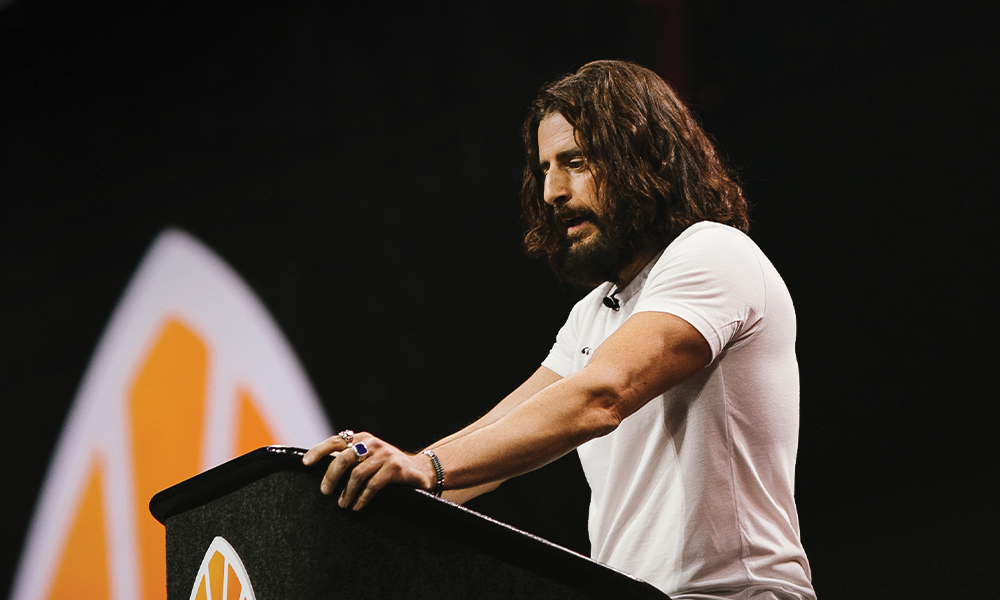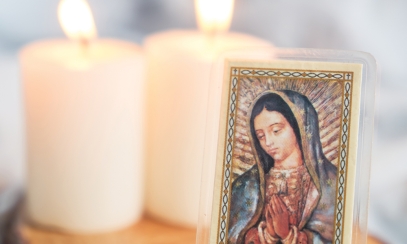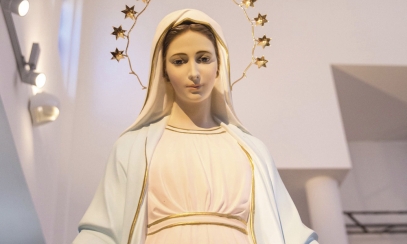
The Eucharist and the art of asking questions
It caught me off guard when my 8-year-old child recently asked: “Dad, doesn’t it get a little weird for you when you think about drinking the blood of Jesus at Mass?”
I tried to explain that it is a great mercy of the Lord that he comes to us in such familiar ways, under the appearances of bread and wine. If we were to receive Christ’s Precious Blood in the Eucharist and our eyes beheld actual human blood, my daughter is correct – this would be challenging. But in his extraordinary delicacy, Jesus comes to us under the richly symbolic veils of bread and wine that make it easy for us to receive him in Holy Communion.
My daughter’s question, and a T-shirt recently worn by a famous actor, both bring to mind aspects of the Eucharist that are at times underappreciated.
“If it’s a symbol, to hell with it!”
Jonathan Roumie, who plays Jesus in the streaming series The Chosen, spoke at the 2024 National Eucharistic Congress. A devout Catholic, he designed and wore a shirt with a striking quote: “If it’s a symbol, to hell with it!” These words were spoken almost 75 years ago by the Catholic novelist, Flannery O’Connor, in response to someone saying that the Eucharist is only “a symbol.” She later commented: “[The Eucharist] is the center of existence for me; all the rest of life is expendable.”
This is a beautiful statement about the centrality of the Eucharist in the life of a Catholic. However, novelists sometimes do not have precision about matters of the Faith. O’Connor’s remark about the Eucharist is true in one sense, but not in another. Let’s look at her remark in more detail, keeping in mind this statement on the website of the U.S. Conference of Catholic Bishops: “the Body and Blood of Christ and are not merely symbols.” The word “merely” is key.
When popes and bishops officially teach about faith and morals, their authority to do so is rooted in the Gospel passage when Jesus founded his one Church on Peter, the first pope. Jesus entrusted to Peter and his successors his own authority to govern and teach. (Mt. 16:13-19) Jesus also gave a portion of his authority to the other apostles, the first bishops of the Church...and to their successors. The authoritative teaching office of the pope and bishops is called the Magisterium.
The Magisterium teaches that the Eucharist is comprised of both the “substance” (the Risen Christ) and the “accidents” -- the appearance and taste of bread and wine which remain after the priest prays the words of consecration ... words which cause the bread and wine to become the body, blood, soul and divinity of Christ. “Substance” in this context refers to the essence of what something is, like the “lily-ness” of a lily. “Accident” refers to what is non-essential, like the fragrance of a lily.
So ... is the Eucharist a symbol?
No…but also yes! In substance – no. The substance of the Eucharist is the Risen Christ! But regarding the Eucharist’s appearances of bread and wine (the “accidents”) – yes. The Church has seen great symbolic significance in the forms of bread and wine beginning as far back as St. Paul.
Think of the hymn, “One Bread, One Body,” based on the saint’s insight about the “accident” of bread. St. Paul saw a powerful symbol of unity in the form of the “one bread” representing the “one body” of the Church. (1Cor 10:16-17)
A few decades later, St. Ignatius of Antioch wrote about the symbolic connection between the wheat of the bread used in the Eucharistic sacrifice and the martyrdom he was about to undergo in the Colosseum, where he was thrown to deadly animals because of his faith in Christ:
Let me be food for the wild beasts, for they are my way to God. I am God’s wheat and shall be ground by their teeth so that I may become Christ’s pure bread.
The accidents of bread and wine are indeed rich symbols – and also powerful signs. All seven sacraments, in fact, are “efficacious signs of grace, instituted by Christ and entrusted to the Church, by which divine life is dispensed to us” (CCC 1131). Only one sacrament is more than just a sign; in the Holy Eucharist, the Risen Lord himself is substantially present. (CCC 1374)
In summary, then, the forms of bread and wine do indeed symbolize and signify Christ’s body and his precious blood. Disregarding the symbolic aspects of the Eucharist, as O’Connor’s famous quote does, risks leaving us with an impoverished appreciation of this unique sacrament.
How would you answer this question about the Eucharist?
The Eucharistic Revival in the United States largely came about because of some responses to a 2019 survey carried out by Pew Research Center, which then claimed only 31 percent of Catholics believed the Eucharist is the Body and Blood of Christ. One question, though, was problematic:
Regardless of the official teaching of the Catholic Church, what do you personally believe about the bread and wine used for Communion? During Catholic Mass, the bread and wine…
- a. Actually become the body and blood of Jesus Christ
- b. Are symbols of the body and blood of Jesus Christ
It might seem surprising, but if I had taken the survey, I would have had no hesitancy saying “yes” to statement “b” because this is what the Church has taught about the “accidents” of bread and wine since the age of the Apostles. However, the word “actually” – which I’m sure was chosen with good intentions – is a concern. The Church does not use the word “actual” when teaching about Christ’s presence in the Eucharist. The Magisterium of the Catholic Church prefers to speak of Jesus’ “Real Presence” in the Eucharist – or his “substantial” or “sacramental” presence.
I remember the way one professor of sacramental theology explained the problem with using a term like “actual” in this context: “The Catholic Church has never taught that when the priest elevates the consecrated host at Mass, the glorified body of Jesus in heaven is also elevated.”
How would you respond to this revised question from Vinea Research?
Not only were some of the questions asked by Pew Research in 2019 unfortunately imprecise, but so was this revised question contained in a 2024 survey carried out by Vinea Research:
Regardless of the official teaching of the Catholic Church, what do you personally believe about the bread and wine used for Communion?
- a. Jesus Christ is truly present in the bread and wine of the Eucharist
- b. Bread and wine are symbols of Jesus, but Jesus is not truly present
The Church would insist we reject statement “b” because it denies the dogma of the Real Presence of Jesus in the Eucharist. However, a faithful Catholic would also have to reject statement “a” since it presents the error of “impanation.” This heresy, which literally means “in the bread,” claims that “the words of consecration do not change bread and wine into the body and blood of Christ. Rather the substance of bread and wine remains, along with some kind of indefinable presence of Christ.” (Modern Catholic Dictionary)
Regarding the Eucharist, the Catholic Church does not teach that Jesus is “in the bread and wine.” Rather, the bread and wine no longer exist – even though we still see the appearance of bread in the Host, and we still perceive the taste of wine when we receive Holy Communion from the chalice. The miracle at every Mass is that the bread and wine become, in substance, the Risen Lord Jesus!
Thankfully, the 2024 study by Vinea produced a more encouraging result, claiming that 69 percent of Mass-going Catholics believe in the Real Presence of Jesus in the Eucharist.
Felix Culpa
The Easter Vigil Mass includes a soaring hymn called the Exsultet, which includes these lines: “O truly necessary sin of Adam, destroyed completely by the death of Christ! O happy fault that earned so great, so glorious a Redeemer!” In Latin, “happy fault” translates as felix culpa – a term that sums up how God can bring good out of error.
Even though the questions asked in two recent surveys about the Eucharist were somewhat flawed, we can thank God that the 2019 survey led to the National Eucharist Revival and Congress, which have been such grace-filled moments for our country and the Church!
Dr. Dan Osborn is the Diocesan Theologian and Coordinator of Permanent Diaconate Formation & Ministry for the Diocese of Saginaw.



